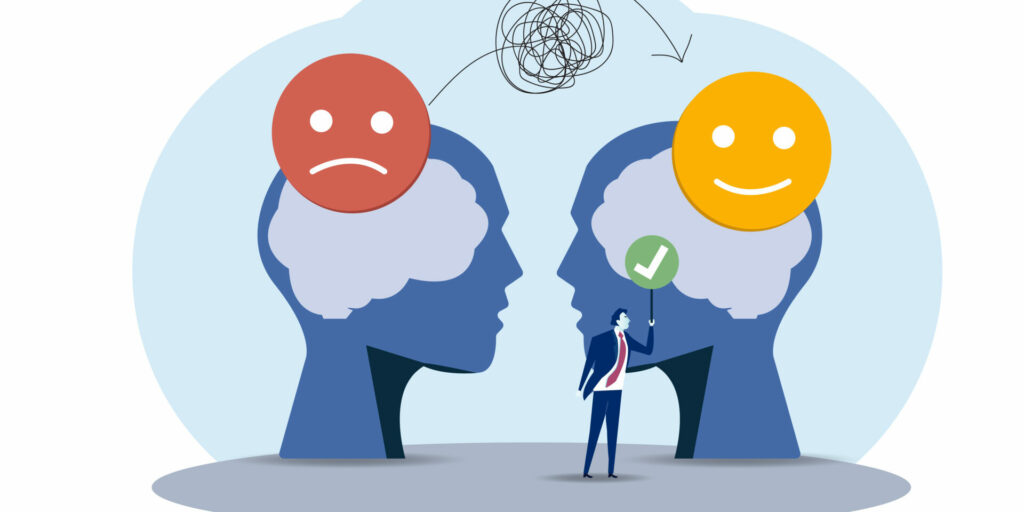Cognitive Behavioral Therapy (CBT) has emerged as a powerful psychological approach for addressing various mental health issues. Among its many techniques, CBT Exposure Therapy stands out as a highly effective method for treating anxiety disorders, phobias, and post-traumatic stress disorder (PTSD). In this article, we will delve into the world of CBT Exposure Therapy, exploring its principles, techniques, success stories, and more.
Contents
Understanding the Basics of Cognitive Behavioral Therapy (CBT)

Cognitive Behavioral Therapy (CBT) is a widely practiced form of psychotherapy that focuses on helping individuals identify and change negative thought patterns and behaviors. It is based on the premise that our thoughts, feelings, and behaviors are interconnected, and by altering dysfunctional thought patterns, we can effectively change our emotions and actions. CBT is a goal-oriented and structured approach that is often used to treat a variety of mental health conditions, including depression, anxiety disorders, phobias, and more. Here are some key basics of CBT:
- Cognitive Restructuring: Central to CBT is the process of cognitive restructuring, which involves identifying and challenging irrational or negative thought patterns. Clients learn to recognize cognitive distortions, such as black-and-white thinking, catastrophizing, and personalization, and replace them with more rational and balanced thoughts.
- Behavioral Activation: In addition to addressing cognitive distortions, CBT also focuses on changing behaviors that contribute to psychological distress. Clients work on setting specific goals and engaging in activities that bring them a sense of accomplishment and pleasure. This can help combat symptoms of depression and improve overall mood.
- Homework Assignments: CBT often includes homework assignments, where clients practice the techniques learned in therapy sessions in their daily lives. These assignments might involve keeping thought journals, engaging in exposure exercises for phobias, or tracking behaviors and associated emotions.
The Role of Exposure Therapy in CBT
The primary goal of exposure therapy is to reduce or eliminate the fear response and associated avoidance behaviors. Here’s an overview of the role of exposure therapy in CBT:
- Understanding the Fear Hierarchy: Exposure therapy typically begins by creating a fear hierarchy, also known as a fear hierarchy or anxiety hierarchy. In collaboration with the therapist, the individual identifies and ranks situations or stimuli that trigger anxiety or fear from least anxiety-provoking to most anxiety-provoking.
- Systematic Desensitization: Once the fear hierarchy is established, exposure therapy involves systematically exposing the individual to these feared stimuli in a controlled and gradual manner. This exposure can be done through various methods:
- In vivo exposure: Real-life exposure to the feared situation or object. For example, if someone has a fear of flying, they might start by visiting an airport without boarding a plane and gradually progress to taking short flights.
- Imaginal exposure: This involves vividly imagining the feared situation or object, either through guided imagery exercises or writing about it in detail.
- Virtual reality exposure: In some cases, virtual reality technology is used to simulate the feared situation, providing a controlled and safe environment for exposure.
- Extinction of Fear Response: The key principle behind exposure therapy is the process of extinction. Through repeated and controlled exposure to the feared stimuli, individuals gradually learn that the feared outcome they anticipate does not occur, or if it does, it is less distressing than expected. This leads to a reduction in the fear response over time.
- Preventing Avoidance: Avoidance behaviors are common in individuals with anxiety disorders or phobias. Exposure therapy helps individuals confront and overcome these avoidance behaviors. As they repeatedly face their fears, they become more resilient and less likely to avoid triggering situations or stimuli.
- Emotional Processing: Exposure therapy also involves helping individuals process and reinterpret their emotional responses to feared stimuli. Therapists work with clients to challenge irrational thoughts and beliefs related to their fears, leading to more adaptive and realistic thinking.
- Generalization: The benefits of exposure therapy are not limited to the specific situations or stimuli in the hierarchy. As individuals become more comfortable and less anxious in the target situations, they often experience a generalization of their reduced fear response to related situations and contexts.
Conditions Treated with CBT Exposure Therapy

Cognitive Behavioral Therapy (CBT) exposure therapy is a highly effective treatment approach for several mental health conditions, particularly those characterized by excessive anxiety, fear, or avoidance behaviors. Here are some of the common conditions that can be effectively treated with CBT exposure therapy:
- Specific Phobias: CBT exposure therapy is often the treatment of choice for specific phobias, which are intense and irrational fears of specific objects or situations. Examples include fear of flying, heights (acrophobia), spiders (arachnophobia), and needles (trypanophobia).
- Social Anxiety Disorder (Social Phobia): Social anxiety disorder involves an intense fear of social situations and scrutiny by others. Exposure therapy helps individuals confront social situations gradually, reducing their anxiety and avoidance of social interactions.
- Generalized Anxiety Disorder (GAD): While CBT for GAD often includes cognitive restructuring, exposure therapy can also be used to address specific anxiety-provoking situations or worries that are central to the individual’s anxiety.
- Panic Disorder: Exposure therapy can be used to desensitize individuals to situations or bodily sensations that trigger panic attacks. This helps reduce the frequency and severity of panic attacks.
- Post-Traumatic Stress Disorder (PTSD): CBT exposure therapy is a key component of trauma-focused treatment for PTSD. It helps individuals confront and process traumatic memories and triggers, reducing the emotional distress associated with the trauma.
- Obsessive-Compulsive Disorder (OCD): Exposure and response prevention (ERP) is a specialized form of exposure therapy used to treat OCD. It involves exposing individuals to their obsessions while preventing the associated compulsive behaviors. This helps break the cycle of obsessions and compulsions.
The Process of CBT Exposure Therapy
Cognitive Behavioral Therapy (CBT) exposure therapy is a structured and systematic process designed to help individuals confront and gradually reduce their anxiety or fear responses to specific situations, objects, or thoughts. Here’s an overview of the typical process involved in CBT exposure therapy:
Assessment and Treatment Planning:
- Initial Assessment: The therapy process begins with an initial assessment where the therapist and the client discuss the nature and severity of the anxiety or fear, relevant history, and treatment goals.
- Establishing the Fear Hierarchy: Together, the therapist and client create a fear hierarchy, also known as an anxiety hierarchy or exposure hierarchy. This hierarchy lists situations or stimuli related to the fear, ranked from least anxiety-provoking to most anxiety-provoking. This hierarchy guides the exposure process.
Psychoeducation: The therapist provides the client with information about the principles of exposure therapy, how it works, and what to expect during the process. This helps the client understand the rationale behind exposure therapy.
Exposure Planning:
- Selecting Exposure Methods: The therapist and client decide which exposure methods will be used. This can include in vivo exposure (real-life exposure to feared situations), imaginal exposure (vividly imagining the feared situation), or a combination of both.
- Setting Goals: Clear, specific goals for each exposure exercise are established. These goals may include time limits for exposure, the intensity of the exposure, or specific behaviors to engage in during exposure.
Exposure Sessions:
- Gradual Exposure: Exposure is typically conducted systematically and gradually, starting with the least anxiety-provoking items on the fear hierarchy and progressing to more anxiety-provoking ones as the client becomes more comfortable.
- Controlled Environment: Exposure sessions are conducted in a controlled and safe environment, either in the therapy office or, for some phobias, in real-world settings. The therapist ensures that the client feels supported and safe throughout the process.
- Monitoring and Feedback: During exposure exercises, the therapist helps the client monitor their anxiety levels and provides guidance and support as needed. The client’s reactions and progress are carefully observed.
The Therapeutic Relationship in CBT Exposure Therapy
Here’s how the therapeutic relationship functions within CBT exposure therapy:
- Establishing Trust and Rapport: Building trust and rapport is the first step in any therapeutic relationship. The therapist creates a safe and supportive environment where the client feels comfortable discussing their fears and anxieties.
- Collaborative Partnership: The therapeutic relationship in CBT is collaborative. Therapists and clients work together as a team to set treatment goals, create exposure plans, and make decisions about the course of therapy. This collaborative approach fosters a sense of ownership and empowerment in the client.
- Psychoeducation: The therapist educates the client about exposure therapy, its principles, and its potential benefits. Clients should have a clear understanding of why exposure is being used and how it fits into their treatment plan. This education helps demystify the process and promotes client buy-in.
- Assessment and Individualization: The therapist conducts a thorough assessment to understand the client’s specific fears, triggers, and emotional responses. This assessment is used to create a personalized exposure plan tailored to the client’s needs and goals.
- Setting Realistic Expectations: The therapeutic relationship involves setting realistic expectations for exposure therapy. Clients are informed that it may be challenging and anxiety-provoking but that they will have the therapist’s support throughout the process.
Benefits of CBT Exposure Therapy

Here are some of the key benefits of CBT exposure therapy:
- Reduction of Anxiety and Fear: Exposure therapy is highly effective in reducing the intensity of anxiety and fear responses. By gradually exposing individuals to their feared situations or objects, they learn that their anxiety diminishes over time. This leads to decreased distress in response to triggers.
- Enhanced Coping Skills: Clients learn valuable coping skills to manage and tolerate anxiety-provoking situations. They develop a toolkit of strategies to handle fear and anxiety, empowering them to confront future challenges more effectively.
- Behavioral Change: Exposure therapy helps individuals break the cycle of avoidance behaviors. As they face their fears, they become less likely to engage in avoidance or safety-seeking behaviors, which can perpetuate anxiety disorders.
- Generalization of Improvement: The benefits of exposure therapy often generalize to other areas of an individual’s life. For example, if someone overcomes a fear of public speaking, they may also experience increased self-confidence and reduced anxiety in social situations.
- Long-Lasting Effects: Exposure therapy is associated with long-lasting results. Clients often maintain the improvements they achieve during therapy, even after treatment concludes, provided they continue to practice the skills they’ve learned.
- Reduced Relapse Rates: For conditions like phobias and certain anxiety disorders, exposure therapy has a relatively low relapse rate. Clients are less likely to revert to their previous avoidance behaviors and fears after successful treatment.
Conclusion
In conclusion, CBT Exposure Therapy is a powerful tool for overcoming anxiety, phobias, and trauma. It offers hope, empowerment, and a path to healing for those willing to face their fears and take control of their mental well-being.
If you are looking for an affordable Online Therapy TherapyMantra can help: Book a trial Online therapy session


